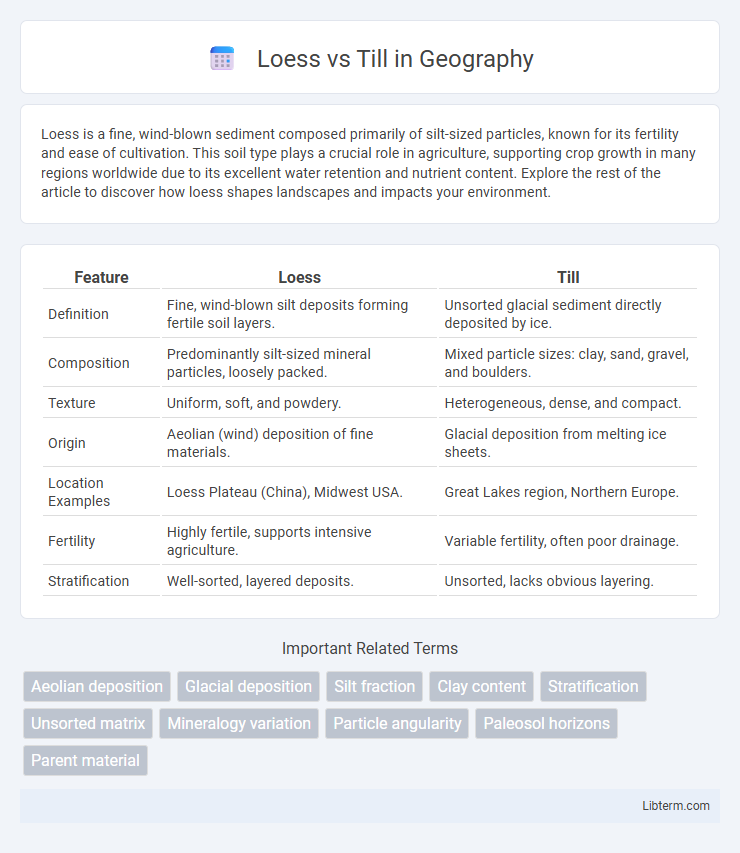Loess is a fine, wind-blown sediment composed primarily of silt-sized particles, known for its fertility and ease of cultivation. This soil type plays a crucial role in agriculture, supporting crop growth in many regions worldwide due to its excellent water retention and nutrient content. Explore the rest of the article to discover how loess shapes landscapes and impacts your environment.
Table of Comparison
| Feature | Loess | Till |
|---|---|---|
| Definition | Fine, wind-blown silt deposits forming fertile soil layers. | Unsorted glacial sediment directly deposited by ice. |
| Composition | Predominantly silt-sized mineral particles, loosely packed. | Mixed particle sizes: clay, sand, gravel, and boulders. |
| Texture | Uniform, soft, and powdery. | Heterogeneous, dense, and compact. |
| Origin | Aeolian (wind) deposition of fine materials. | Glacial deposition from melting ice sheets. |
| Location Examples | Loess Plateau (China), Midwest USA. | Great Lakes region, Northern Europe. |
| Fertility | Highly fertile, supports intensive agriculture. | Variable fertility, often poor drainage. |
| Stratification | Well-sorted, layered deposits. | Unsorted, lacks obvious layering. |
Introduction to Loess and Till
Loess is a wind-deposited sediment composed mainly of silt-sized particles, typically found in fertile agricultural regions due to its porous texture and high nutrient content. Till is an unsorted glacial deposit consisting of a mixture of clay, sand, gravel, and boulders, left behind directly by melting glaciers and characterized by poor drainage and variable composition. Understanding the distinct origins and physical properties of loess and till is crucial for soil classification, land use planning, and environmental management.
Formation Processes of Loess
Loess forms primarily through the accumulation of wind-blown silt-sized particles, often derived from glacial outwash plains and arid regions where fine sediments are abundant. Its formation involves aeolian processes, where strong winds transport and deposit mineral-rich dust over extensive areas, creating thick, homogeneous, and porous deposits. Unlike till, which is a result of direct glacial deposition, loess deposits reflect post-glacial or non-glacial wind activity that redistributes loose sediments.
Formation Processes of Till
Till forms through glacial processes as unsorted sediment directly deposited by melting glaciers, consisting of a heterogeneous mix of clay, sand, gravel, and boulders. Unlike loess, which is windblown silt accumulated over time, till results from the mechanical grinding and plucking actions of glacier movement. The composition and texture of till reflect its origin beneath or within ice, creating a dense, compacted deposit indicative of past glacial activity.
Key Physical Characteristics
Loess is a fine-grained, windblown sediment composed mainly of silt-sized particles, characterized by its uniform texture and high porosity, which enhances water retention and root penetration. Till, in contrast, is an unsorted glacial deposit containing a heterogeneous mix of clay, sand, gravel, and boulders, resulting in variable texture and low permeability. The distinct particle size distribution and compaction levels in loess versus till significantly influence soil drainage, fertility, and suitability for agriculture.
Geographic Distribution and Occurrence
Loess deposits predominantly occur in mid-latitude regions such as the central United States, parts of China, and Europe, where wind-blown silt accumulates extensively in periglacial environments. Till, by contrast, is widespread in glaciated regions including Canada, Scandinavia, and northern Europe, forming directly from the unsorted debris deposited by retreating glaciers. The spatial distribution of loess is closely linked to past glacial outwash plains and arid conditions, whereas till is characteristic of areas covered by continental ice sheets during the Pleistocene.
Soil Fertility and Agricultural Impact
Loess soil, composed mainly of fine silt-sized particles, is highly fertile due to its excellent drainage, aeration, and mineral content, promoting robust crop growth and sustaining intensive agriculture. Till soil, a heterogeneous mix of clay, sand, gravel, and boulders deposited by glaciers, often exhibits variable fertility and requires careful management to optimize nutrient availability and improve soil structure. The loess's consistent texture and nutrient-holding capacity typically enhance agricultural productivity more effectively than the coarser, less uniform till deposits.
Loess vs Till: Erosion and Stability
Loess is composed of fine, wind-blown silt particles that exhibit high porosity and moderate cohesion, making it susceptible to erosion but generally stable on gentle slopes. Till consists of unsorted glacial debris with varied particle sizes, providing stronger structural integrity and greater resistance to erosion due to its compact and heterogeneous nature. The erosion rates of loess are typically higher compared to till, resulting in differing landscape stability and sediment transport dynamics in areas dominated by these materials.
Environmental Significance
Loess, a wind-blown silt deposit, significantly enhances soil fertility and water retention, promoting robust agricultural productivity in many regions. Till, an unsorted glacial deposit, impacts landscape formation by influencing drainage patterns and soil composition, often leading to varied ecosystems. Understanding the environmental significance of both materials aids in land use planning, conservation, and sustainable agriculture strategies.
Human Utilization and Management
Loess, composed of fine, wind-blown silt, offers fertile soil ideal for agriculture due to its high nutrient content and water retention capacity, making it a priority for crop cultivation and land management. Till, a heterogeneous mix of clay, sand, and gravel deposited by glaciers, requires more intensive soil management techniques such as drainage and fertilization to optimize its agricultural potential and support sustainable land use. Effective human utilization of loess leverages its natural fertility for farming, while till demands targeted interventions to improve soil structure and productivity.
Summary: Choosing Between Loess and Till
Loess is a wind-deposited, fine-grained sediment known for its fertility and good drainage, making it ideal for agriculture. Till, a glacially deposited mixture of clay, sand, gravel, and boulders, supports diverse soil types but often requires more management due to variable texture and drainage issues. Selecting between loess and till depends on factors like soil fertility needs, drainage capacity, and land use goals, with loess favored for crop production and till suited for variable terrain and construction purposes.
Loess Infographic

 libterm.com
libterm.com